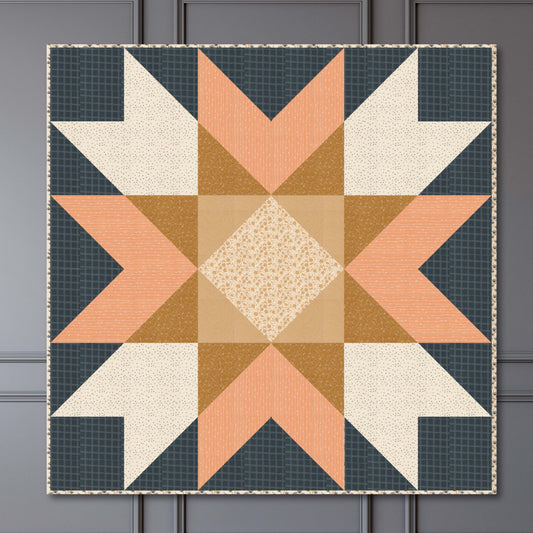
Curves. The misunderstood step-child of quilting. I know they can seem scary, but really, there is nothing to be afraid of. Curves are magical, and you’ll see why after making some!
Making curves in quilt blocks can add depth and visual interest to your quilt designs, but they can also be intimidating for quilters who are used to working with straight lines.
Snag The Guide

How to Sew Curved Quilt Pieces
With a little practice and the right tools, anyone can learn to make beautiful curved quilt blocks.
Like everything else in life, you just have to follow some rules and you’ll be golden. I promise by the end, you’ll not only be more comfortable with curves, you’ll want to make a quilt with curves (hello Isola Quilt Pattern!!).

How Do Curves Come Together?
Honestly, it’s practically magic (which reminds me of one of my fav movies of all time: Practical Magic... anyways back to curves!).
Here are some tips for sewing curves as well as a general tutorial that will help with any curve piecing in quilting or sewing.

Choose the Right Fabric
To make curved quilt blocks, you will need to use fabrics that are easy to manipulate and have a little bit of stretch (not too much!) to them. Cotton or cotton blends are good choices, as they have a nice drape and can be easily pinned and sewn.
Avoid using fabrics that are too stiff or have a lot of texture, as these can make it more difficult to create smooth curves. I use standard quilting cotton from Art Gallery Fabrics, Kona, or Moda Bella Solids.

Gather Your Tools
You will need something to secure the curved pieces. Some quilters swear by pins and generally that is what I use. I’ve seen other quilters (like my tester for the Isola quilt pattern Ember Craft) use a small glue stick to secure them prior to sewing.
Whatever you choose, when first learning how to sew curves, don’t be afraid to use ALL the things to help secure it together.
Cut Your Fabric
The Isola quilt pattern comes with two templates to help you cut your curve blocks. These are specially designed to fit together perfectly with a scant ¼” seam allowance. Cut out the templates from thicker paper (like cardboard). Use a heavy object to weigh the template down.
If you are using a template, be sure to align it with the grain of your fabric and use a light pencil to mark your cutting lines. I usually skip marking and just use a rotary cutter very slowly around the template.
Pin the Curve Pieces
Either pinning or gluing is ideal when working with curves. Fold your pieces in half and mark them in half. Align the two markings of the top inner curve and the top of the bottom curve.
Pin these together. Move to the edges and pin those together so the curves are matching.
Slowly move in, lining up the curves by gently (very gently!!) conforming the curves to each other.
Pin the whole length at first, later you may not need as many.


 Sew Your Curves
Sew Your Curves
To sew your curves, start at one end of the inner circle and carefully stitch along the edge of your fabric wedges. Use a small, even stitch length, and try to keep your fabric as smooth as possible as you sew.
The most important thing is to let the machine feed the fabric smoothly, so your circles are irregular or wonky. I can guarantee they will be in the beginning!
But after practice you’ll feel more how the machine can gently round the curves to make perfect seam allowances.

Press Your Seams
Once you have sewn all of your curves, it's time to press your seams. Use a dry iron to press your seams open, taking care not to stretch or distort the fabric.
You can also press towards the darker fabric if you prefer, however I found my circle blocks were a little crisp when I pressed the seams open.

Trim Your Curve Block
Once your seams are pressed, it's time to trim your block to the desired size. You can use a quilting ruler and rotary cutter to do this.
Be sure to follow the pattern’s guidance on sizing. The curve blocks in Isola are a few inches bigger on all sides to allow for more aggressive trimming. This can be SO helpful for beginners.


By following these steps, you can make beautiful curved quilt blocks that add visual interest and depth to your quilts.
With a little practice and the right tools, anyone can learn to make curves in their quilt blocks, so don't be afraid to give it a try!
Any questions? Put them in the comments! Or join the private FB group so we can chat!




3 comments
Looking forward to trying your way, similar to what I do now 🙏
Thank you for the easy to use guide. Since I first learned in 1980’s. I have seen several different ways for curves, many used glue. I like your method. It’s basic and you gave us a guide we can share with others.
———
Quiltd Studios replied:
I’m so glad that it’s helpful, curves don’t have to be as scary as they are!
Can’t wait to try it. Merci
———
Quiltd Studios replied:
I hope it goes well! They are easier than you think :)